Updated: January 24, 2024- 14 min read
Ah, the go-to-market strategy—a term you've likely heard dozens of times but may still find elusive when it comes to actually creating one. Designing a go-to-market strategy is both an art and a science, a balancing act that calls for skill, intuition, and data-driven rigor. So, let's dive right in and demystify what it takes to create a GTM strategy that hits the mark.
Editorial note: This post is based on a talk by Kalyan Banerjee, Amazon Principal Tech PM, on Designing a Go-to-Market Strategy and contains additional insights and examples from the Product School team. You can watch the webinar in full above.
What’s a go-to-market strategy?
A go-to-market (GTM) strategy is essentially your game plan for delivering a product to your target customers. Think of it as the GPS guiding you from initial product development all the way to product launch. This roadmap is a crucial component in your product management toolkit; it outlines the channels, tactics, and timelines to help you make your product not just another name in the market, but a brand people recognize and trust.
Why is it so critical? Well, a successful GTM strategy aligns perfectly with customer needs, market demands, and business objectives. It's the blueprint that ensures you're not just shooting in the dark but are targeting the right audience, through the right channels, with the right message. It's not about launching a product; it's about launching it successfully.
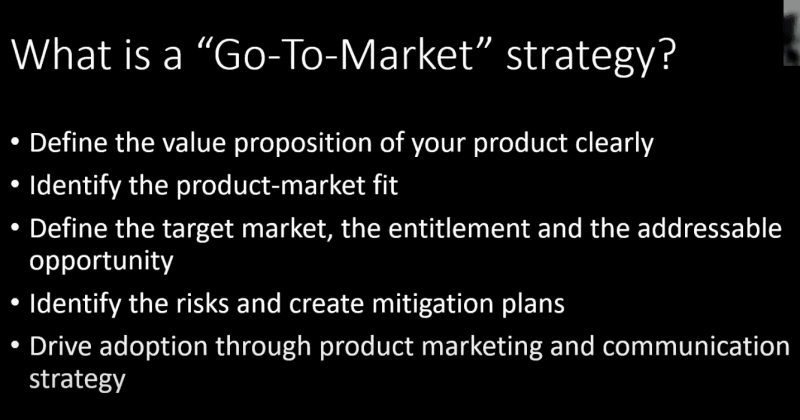
So, ready to craft or refine your own go-to-market strategy? Let's get into the nitty-gritty of turning your product into the next big thing.
Define the value proposition of your product
The value proposition is the cornerstone of your product and the essence of what you're bringing to market. As your product matures, so does its value proposition. It evolves, refines, and may even pivots as you gain more insights into customer needs and market dynamics.
When you're charting out your go-to-market strategy, however, there's no room for ambiguity. You must be laser-focused on what sets your product apart. Is it an unparalleled user experience? Cost-efficiency? Groundbreaking innovation? Whatever it is, this is the moment to lock it in. Why? Because your value proposition isn't just an internal guiding North Star; it's the compelling narrative you'll use to win over customers, stakeholders, and even skeptics.
Identify the product-market fit
So you've nailed down your value proposition. Fantastic! But hold off on the champagne for just a moment—your next critical task is to validate your product-market fit. Yes, your product may have outstanding features and a value proposition that shines, but does it actually solve a problem that's pressing enough for your target market to care?
Understanding product-market fit is like dating—you're essentially looking for that magical "click" between what your product offers and what the market wants. Your aim is to satisfy a specific need or solve a particular problem for your customer segment, and do it so well that the market not just accepts but embraces your solution.
To get this right, engage deeply with your potential users. Conduct interviews, disperse surveys, and observe user behavior. Are they delighted, frustrated, or indifferent to what you offer? Once you have these insights, compare them to your value proposition. Are you solving a problem that's actually a problem? Is that problem significant enough to warrant the solution you're providing?
So, markets evolve and needs change. But if you've done your homework, and your product slides into the market seamlessly, then you're not just setting up for a launch—you're laying the foundation for long-term success.
Go ahead, and dive deep into understanding whether your product's value proposition and the market's needs are in harmonious alignment. Because when they are, you're not just a product leader, you're also a market leader.
Define the target market, the entitlement, and the addressable opportunity
Now it's time to get even more granular. You need to zero in on your specific target market. Who exactly are these people facing the problem your product aims to solve? Identifying your target audience isn't just customer profiling; it's akin to drawing the map for your entire go-to-market journey.
Once you've got that down, let's talk numbers. Define the financial entitlements associated with this target market. How much revenue do you realistically expect to generate over time? But don't stop there. Take it a step further to identify your addressable opportunity. Sure, the total market could be colossal, but based on your market share goals and adoption rates, what slice of the pie can you actually capture?
Identify the risks and make a mitigation plan
It's the time to conduct an unflinching risk assessment. Are there gaps in your knowledge, or even blind spots? As you list down these risks, you should also chalk out a mitigation plan. You need to demonstrate that you've considered known risks and formulated strategies to counter them.
Drive adoption through product marketing and communication strategy
This is where you switch gears from "build" to "buzz." Your communication plan should not just be about shouting your message from the rooftops. It should be a meticulous blueprint aimed at winning the hearts and minds of your target customers. That means creating targeted messaging, leveraging appropriate channels, and employing persuasive tactics to convert interest into adoption.
Your product needs an audience that knows it, trusts it, and most importantly, uses it. Once you've got this trifecta in place, you’re not just launching a product, you’re creating a market phenomenon.
Working backward from the customer
You may have a killer product, but without customers, it's like a party with no guests. To win customers, you need a go-to-market (GTM) strategy that's built around them. Let's break down how you can work backward from the customer to create a strategy that’s foolproof.
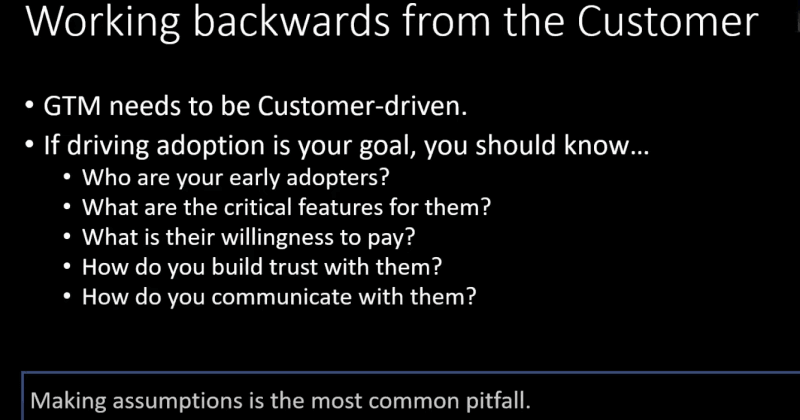
GTM needs to be customer-driven
At the core of your strategy, the customer reigns supreme. Everything from your value proposition to your product-market fit and target segmentation should be guided by your understanding of the customer. Your strategy isn't just customer-focused, it's customer-obsessed.
Driving adoption as your goal
Whether you're targeting a niche market or aiming for high profitability, the end game is adoption. You need customers using your product, not just talking about it.
1. Who are the most likely customer segments to adopt your product?
Think of these segments as your early adopters. You need to identify them and then focus your marketing efforts to suit their specific needs. These are your low-hanging fruits; grab them before someone else does.
2. What are the critical features for them?
Why would they switch to your product? Is it because there's a gap in the market, or maybe because they find your pricing more appealing? Identify those critical features that act as a customer magnet. The key here isn't just to understand what they want but why they want it.
3. What is their willingness to pay?
Your pricing shouldn't be a mere imitation of your competitors. Especially as a newcomer, you don't have the luxury of riding on brand value. Conduct customer outreach, perform economic analysis, and launch surveys to determine a price point that will not only attract but retain customers.
4. How do you build trust with them?
You might be new to the market, but your product shouldn't feel that way to your customers. Whether it's through stellar customer service, reliable sales, or uncompromising data privacy, you need to build trust. Remember, a trusted brand is a brand that lasts.
5. How do you communicate with them?
Your channels of communication should facilitate a two-way street. Sure, you want to tell them about all the fantastic features your product offers, but you also want to hear their feedback, concerns, and suggestions. Whether it's through in-person meetings, customer surveys, or social media engagement, make sure you're not just speaking but also listening.
Data is your best friend
One of the gravest mistakes you can make is to base your strategy on assumptions. Every point mentioned above needs to be backed by solid data. It's like navigating through a maze; you need to have a map. Your customers are that map, and their data are the signposts.
Measuring the success of your GTM
Okay, you’ve done the homework. You’ve zeroed in on your target customers, framed your go-to-market strategy around them, and you're all set to roll. But wait a minute. How do you know if it's working? Good news: measuring the success of your GTM strategy isn't just possible; it's imperative.
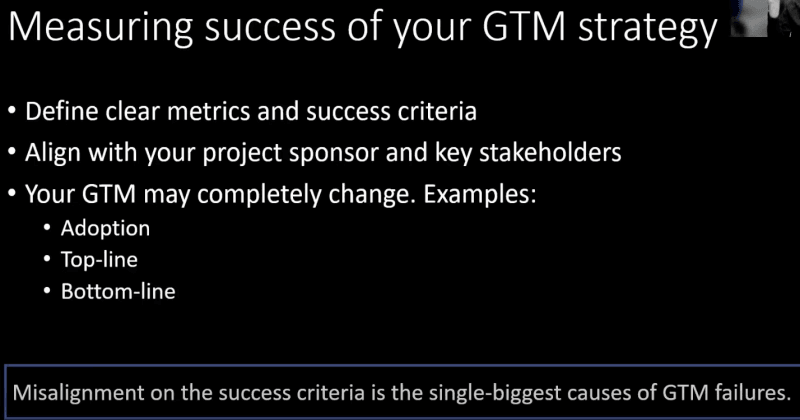
Define metrics and success criteria
Ever heard the saying, "What gets measured, gets managed"? Well, it's your mantra now. You can't simply unleash your product into the world and hope for the best. Hope isn't a strategy. You need solid metrics. Whether it’s monthly active users, net revenue, or customer lifetime value, pick a number—any number—that best represents your goals. This gives you and your team a target to aim for and quantifies your success in black and white.
Align with your key stakeholders
Make sure that you’re on the same page with your key stakeholders—whether they're in upper management, sales, or even customer support. Consensus on what metric to track and what success looks like is pivotal. Failure to align can turn your GTM strategy into a hot mess, and you don't want to be the one cleaning that up.
Be flexible, your GTM strategy may change!
Your product evolves. So, your metrics may also need to adapt. Initially, you might be focusing on user adoption to get those first critical numbers. Later, your focus could shift towards revenue or profitability. This, in turn, might require you to pivot from small-scale sellers to high-value clients.
Avoid misalignment
Imagine this: You hit your target metric with flying colors, but your stakeholders expected something entirely different. Misalignment is not just a hiccup; it can be a fatal flaw in your GTM strategy. Make sure everyone's expectations are clearly outlined and agreed upon.
Always be open to strategically pivoting your strategy
The art of the pivot is a term that's become almost cliché in the startup world, but let's not underestimate its importance. You've meticulously crafted your go-to-market strategy, set your metrics, and launched with unbridled enthusiasm. Fast-forward six months, and you're nowhere near where you expected to be. It's time to ask the hard questions and possibly make some even harder decisions.
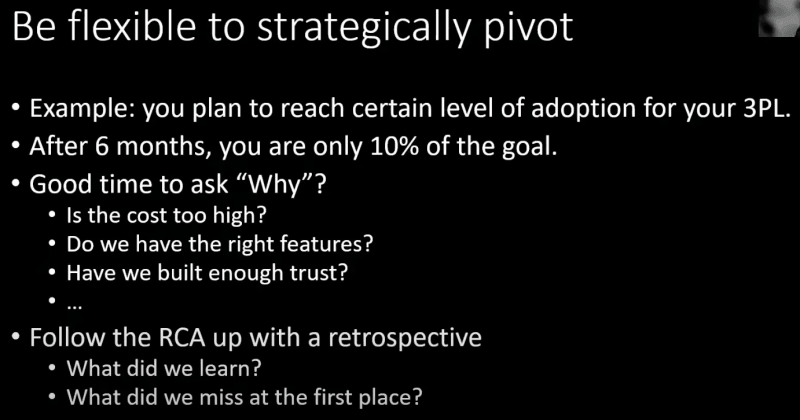
Know when to pivot
There's no sugarcoating it: if you're six months into execution and you're hovering around a 10% achievement rate of your set goals, something's amiss. The market has given you feedback, and you need to listen. Perhaps your pricing is off-kilter, or maybe there's a glaring feature gap.
Sometimes, the issue is subtler, rooted in an intangible lack of trust or an unidentified customer need. And here's the kicker: Customers may not even articulate these needs and reservations. It's your job to dig deep. You need to engage with early adopters, run surveys, or whatever it takes to get beneath the surface.
Make quick, strategic changes
Discovered a missing feature that's a deal-breaker for your customers? Roll up your sleeves and get it into the development pipeline, stat. Realized that customers are uneasy about your data privacy measures? It's time to double down on earning their trust. The key is to make these pivots decisively and align them with your ultimate objectives, whether they be user adoption, revenue, or other KPIs.
Follow the Root Cause Analysis (RCA) with a retrospective
After you've identified the root causes and decided on a path forward, a retrospective is your next best friend. A retrospective is not just a corporate post-mortem; it's a learning loop. What did you overlook in the initial stages? Was the issue something inherent to your initial assumptions, or did you need the sting of real-world experience to understand it? The retrospective is a chance to look back as you prepare to move forward.
The beauty of a retrospective is that it contributes to your growth, not just the product's. It's a habit, a muscle you build. When you've got the maturity to say, "This didn't work, and here's what I'll do differently next time," you're not just troubleshooting a product; you're advancing your career.
So, remember, a strategy is a hypothesis. If data and experience refute it, be willing to change. Staying flexible doesn't mean you're indecisive; it means you're smart enough to adapt to new information. The best product leaders aren't just open to pivoting; they excel at it.
Hard-earned insights
Every GTM strategy is a unique journey. Yet, certain timeless truths emerge as patterns, offering invaluable lessons. Buckle up as we break down these hard-earned insights.
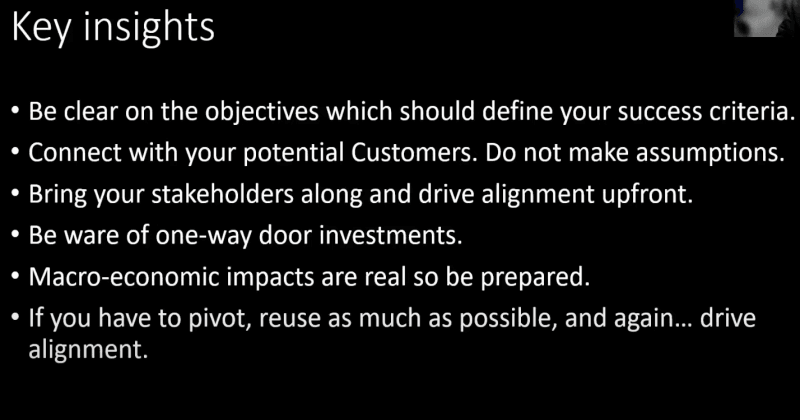
1. Be clear on the objectives that should define your success criteria
Having vague or overly broad goals is like sailing without a compass—you won't know if you're off course until it's too late. For example, rather than saying "increase user engagement," strive for precision: "increase monthly active users by 20% in Q3." By defining specific, measurable, achievable, relevant, and time-bound (SMART) objectives, you create a roadmap for your GTM strategy that can be clearly communicated and tracked.
2. Connect with your potential customers and don't make assumptions
Engaging directly with potential customers through interviews, surveys, or even quick Twitter polls can give you a pulse of the market. Imagine developing a new photo-sharing app, assuming everyone values filters. You launch, only to find out users actually crave better tagging options. Bypass this blunder by talking to potential customers upfront, and let data, not assumptions, drive your decision-making.
3. Bring your stakeholders along and drive alignment upfront
Contrary to popular belief, disagreement among stakeholders isn't necessarily a bad thing; it offers fresh perspectives that can refine your GTM strategy. The trick lies in navigating these different viewpoints to reach a consensus. Having regular alignment meetings, perhaps even inviting stakeholders to customer interviews, ensures everyone is on the same page and invested in the success of your GTM strategy.
4. Be aware of the one-way door investment
Investments are necessary, but some are irreversible and laden with implications for your entire operation. Let's say you choose to integrate blockchain into your payment system. It's an expensive, one-way door that's hard to undo. Always assess the reversibility of your investments. If you need to pivot, what are the sunk costs? Could there be a less rigid, two-way door decision? Consider this in your strategy's financial and resource allocation plans.
5. Be prepared for macroeconomic impacts!
Whether it's a global pandemic, trade wars, or a sudden spike in inflation, the economy is a volatile beast. While you can't predict every curveball, you can build a buffer into your GTM strategy. Have Plan Bs and Cs that account for varying degrees of environmental uncertainty. It's better to pivot based on a premeditated contingency than to react in panic mode.
6. Reuse as much as possible
The beauty of agility is not just in the pivot but also in the conservation of resources. If you've invested months developing a feature set that didn't resonate, can elements be recycled for another user problem? Maybe those chat functionalities can morph into a customer support tool. After your pivot, revisit your stakeholder alignment. Circumstances have changed, and it's likely that their priorities and concerns have too.
In conclusion, your GTM strategy isn't a set-it-and-forget-it deal. It's a living document that evolves with market feedback, stakeholder input, and yes, even global crises. Keep these insights in your toolkit as you navigate the thrilling yet perilous waters of product management.
Wondering how to get started? Check out this Product Launch Template with a GTM Checklist!
Learn more with Product School
Excel in crafting GTM strategies to drive your Product teams to success with our https://productschool.com/product-leader-certification Product Leader Certification (PLC) designed by successful Product Leaders to help you build end-to-end product development skills while offering the hands-on experience you need to lead product teams.
Discover PLC today, and take the first step towards becoming a strategic, successful, and influential Product Leader. Schedule a call today to find out more.
Updated: January 24, 2024





